
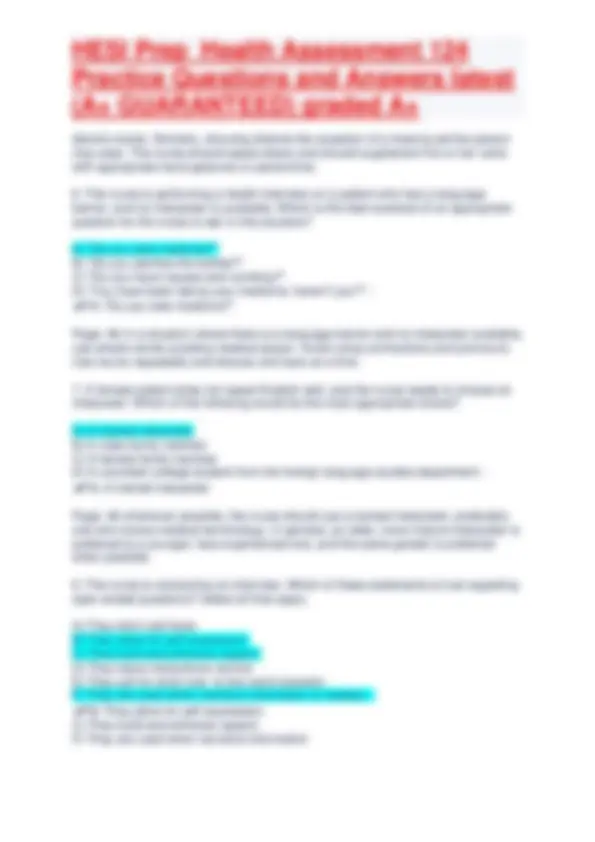
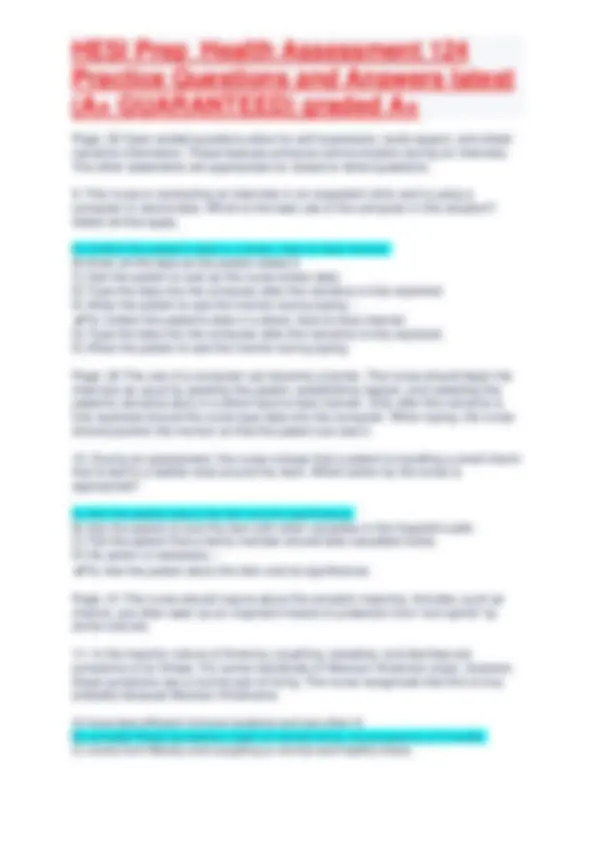
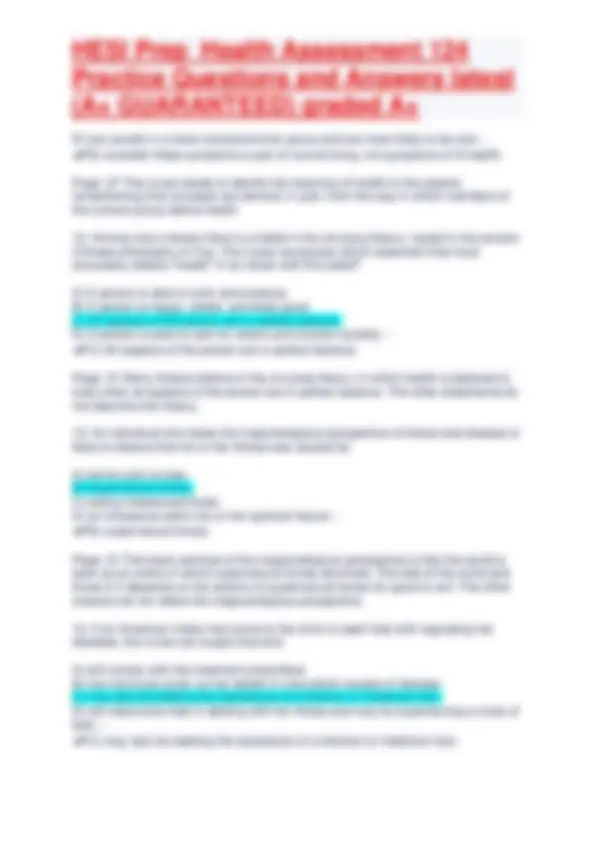
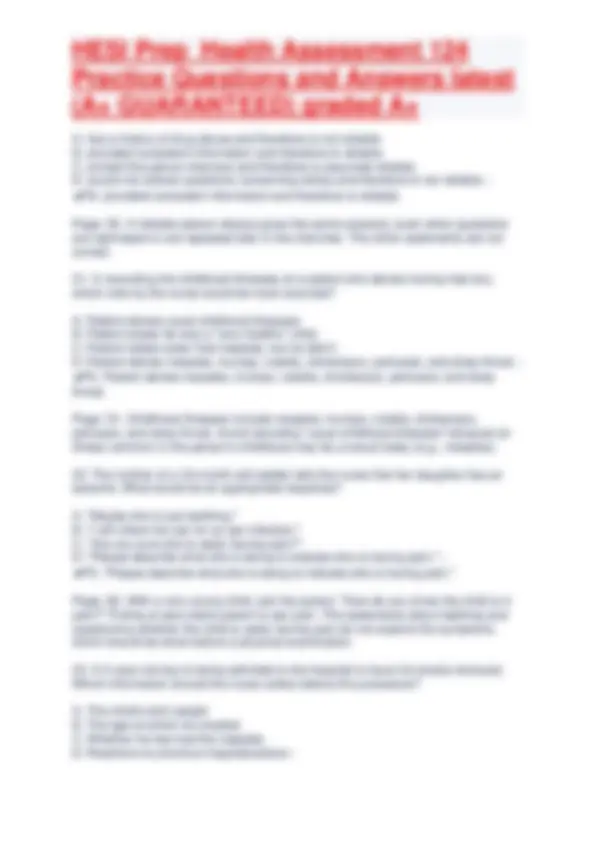
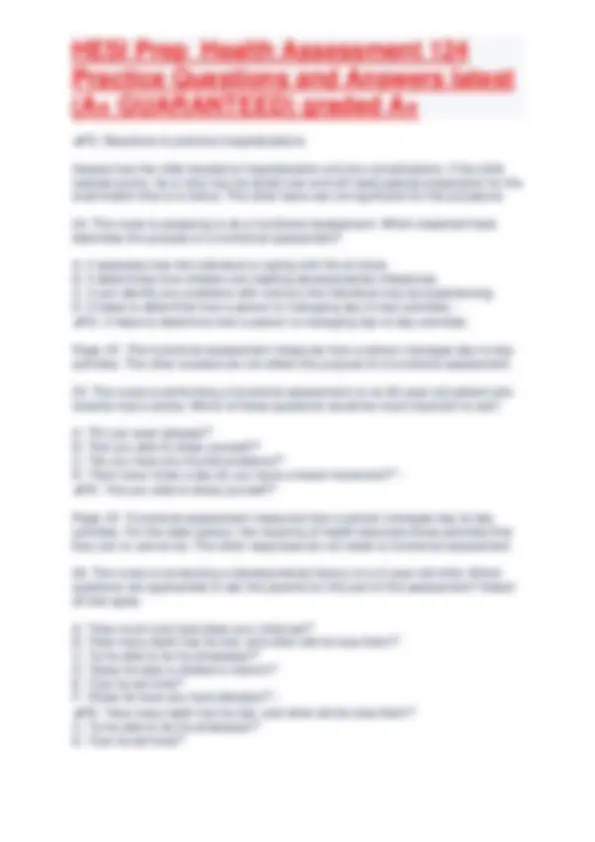
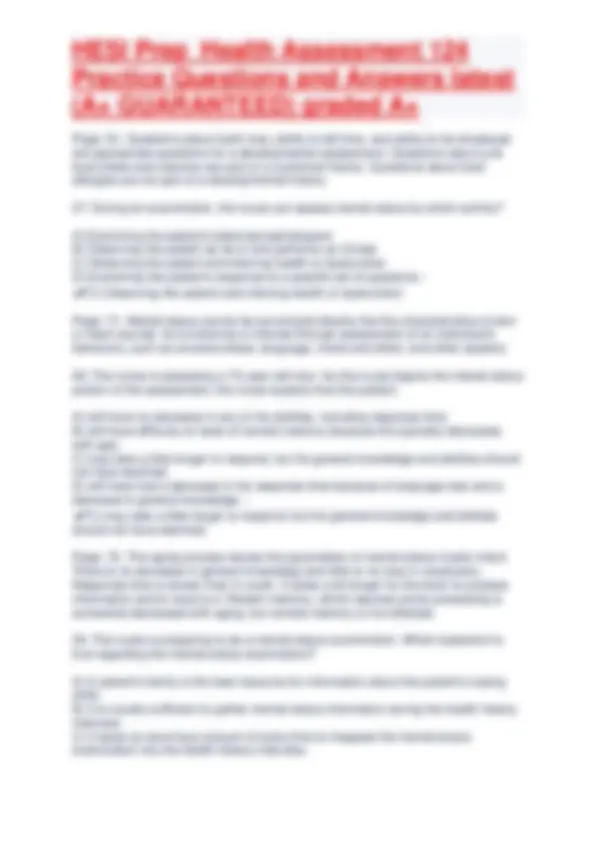
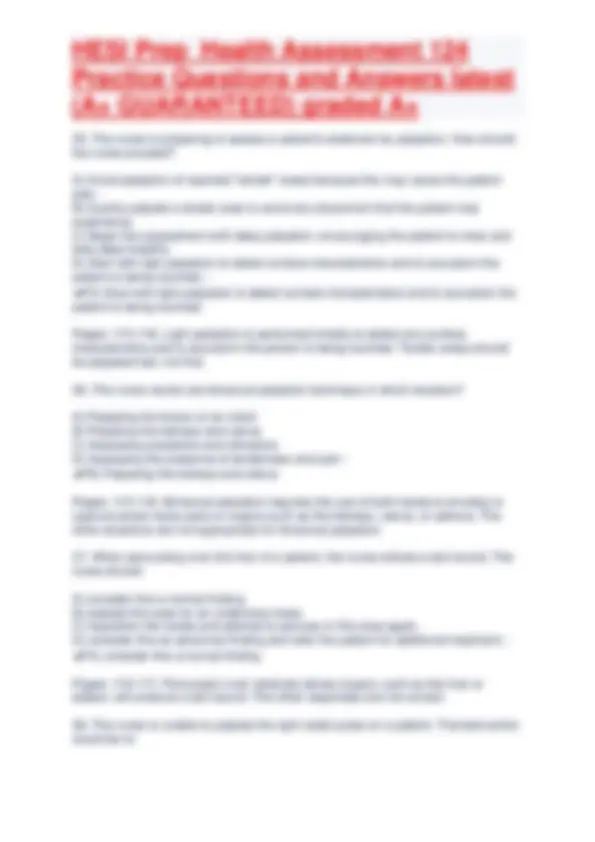
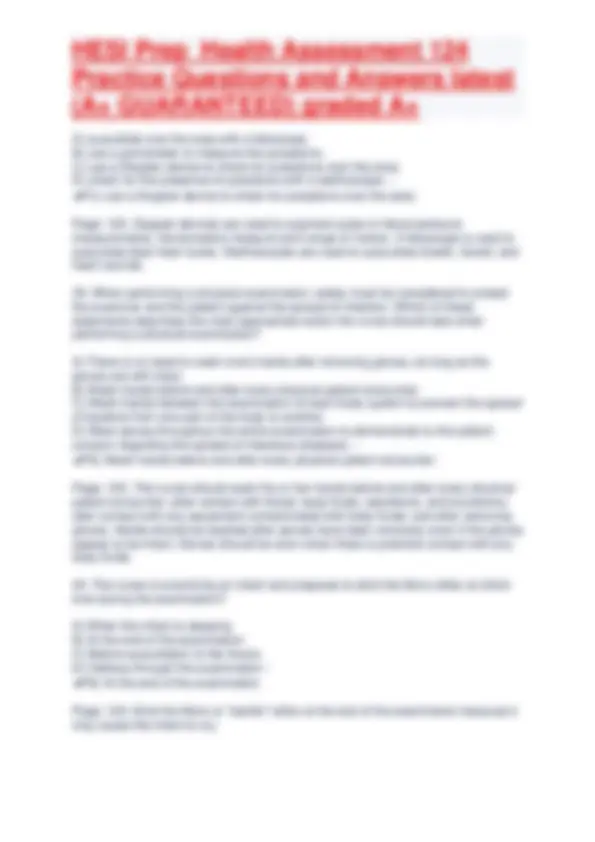
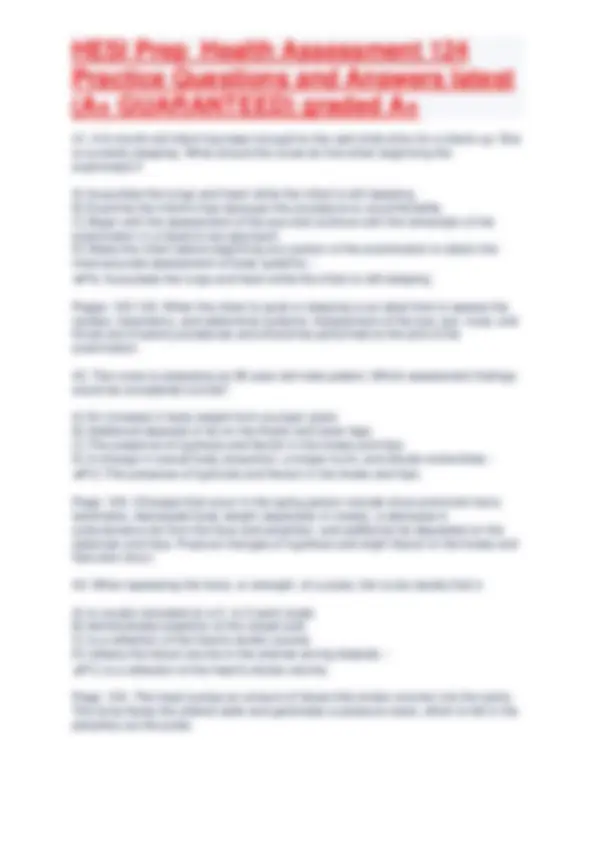
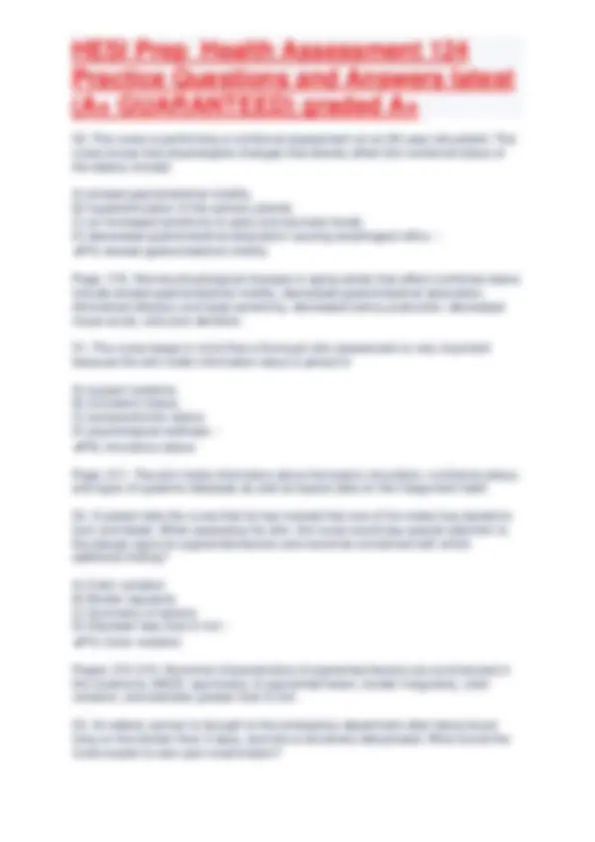
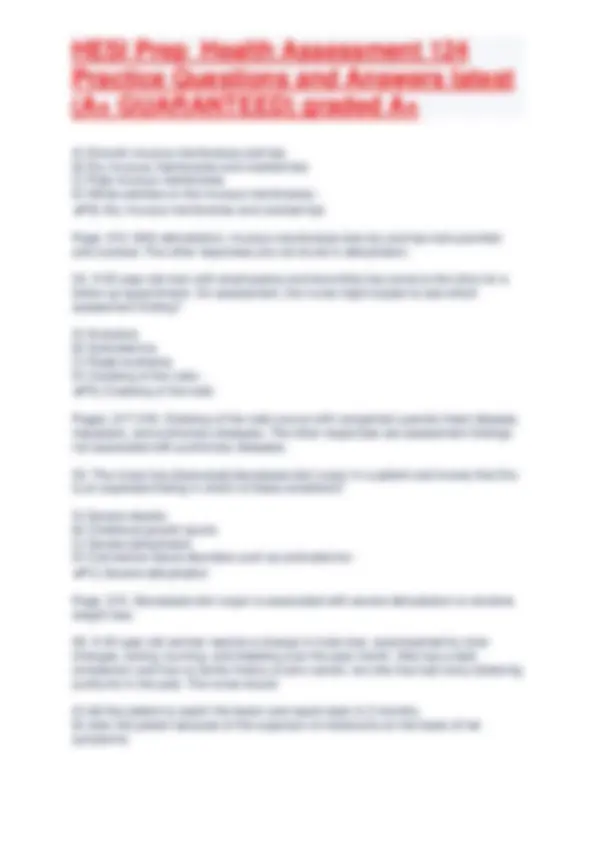
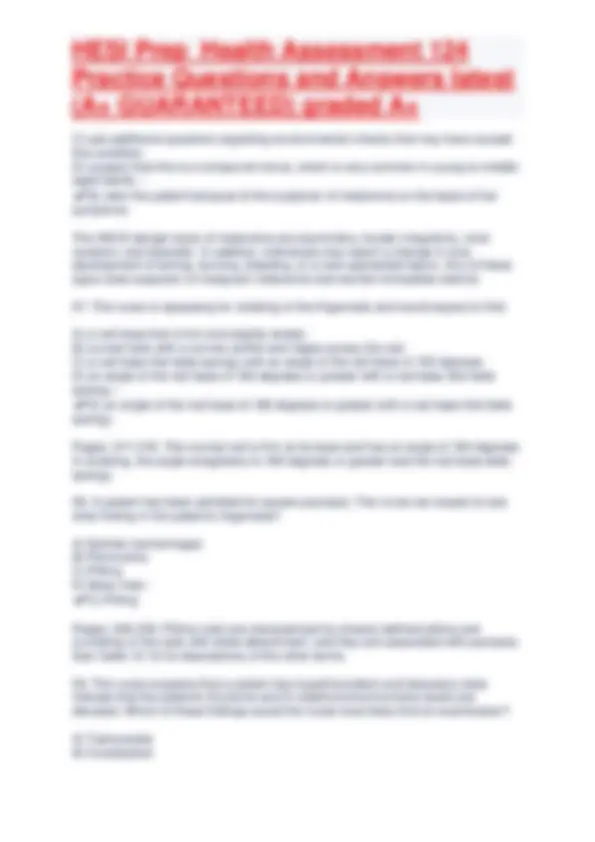
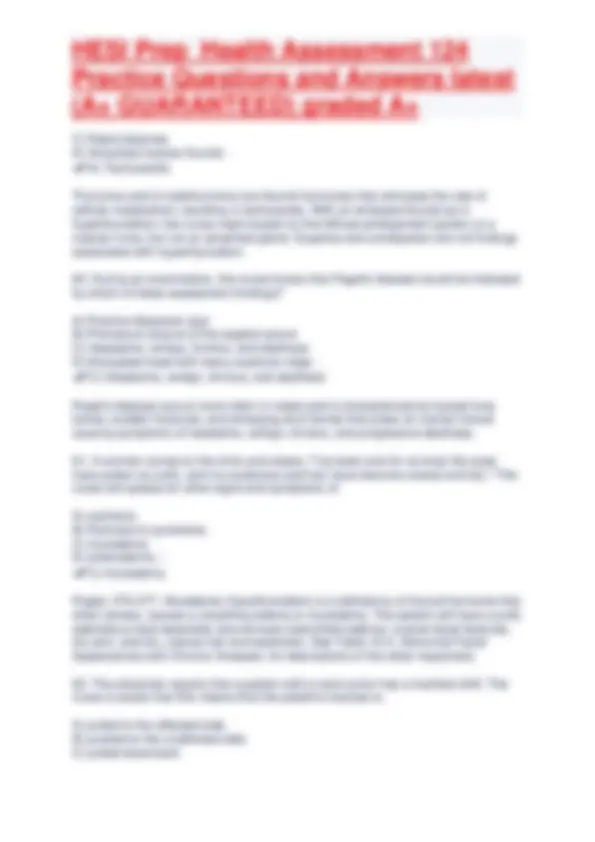
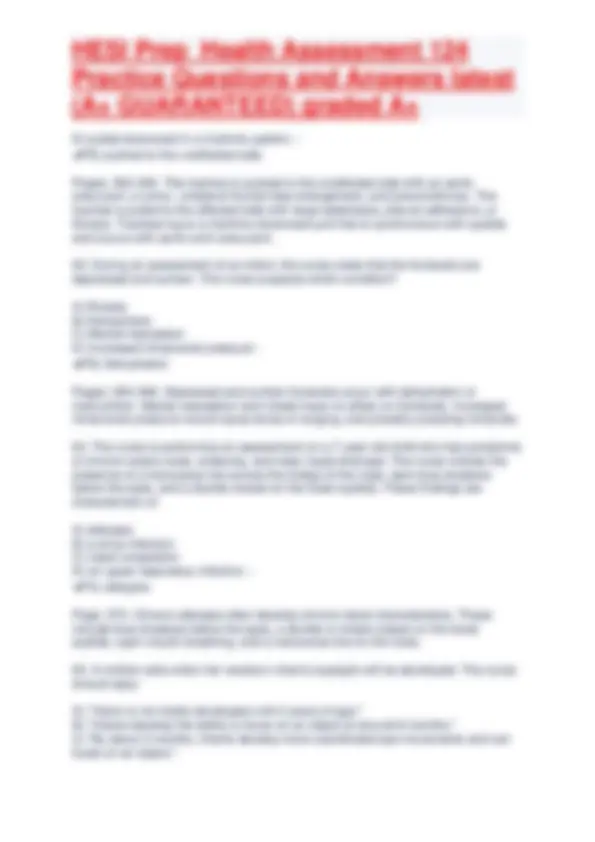
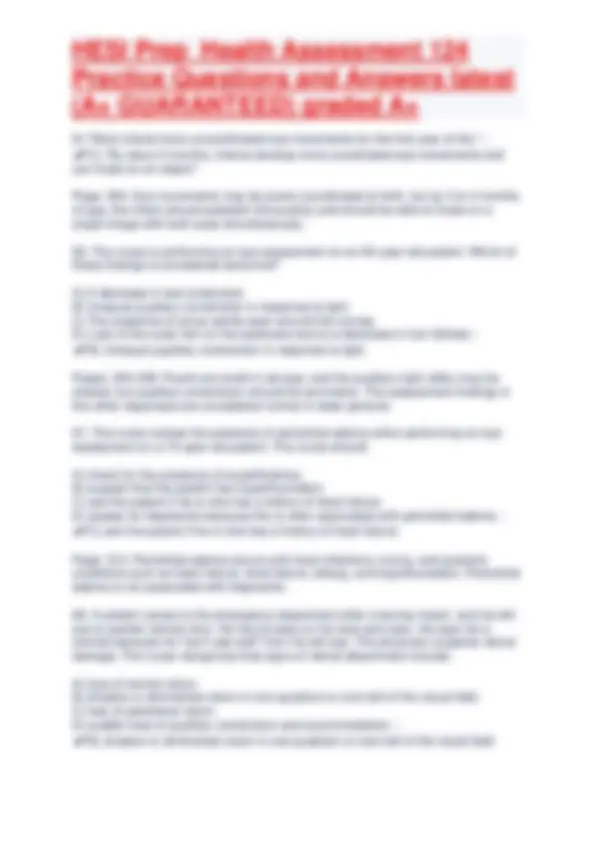
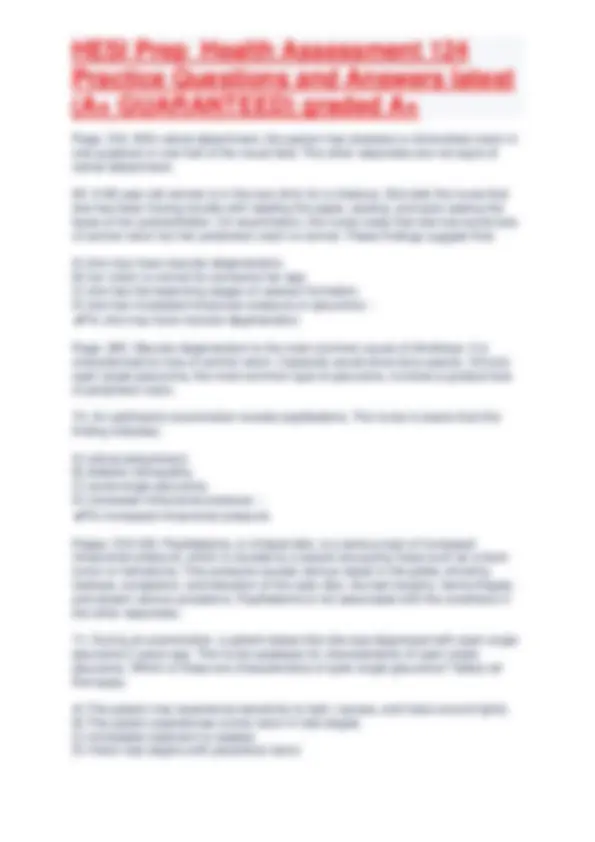
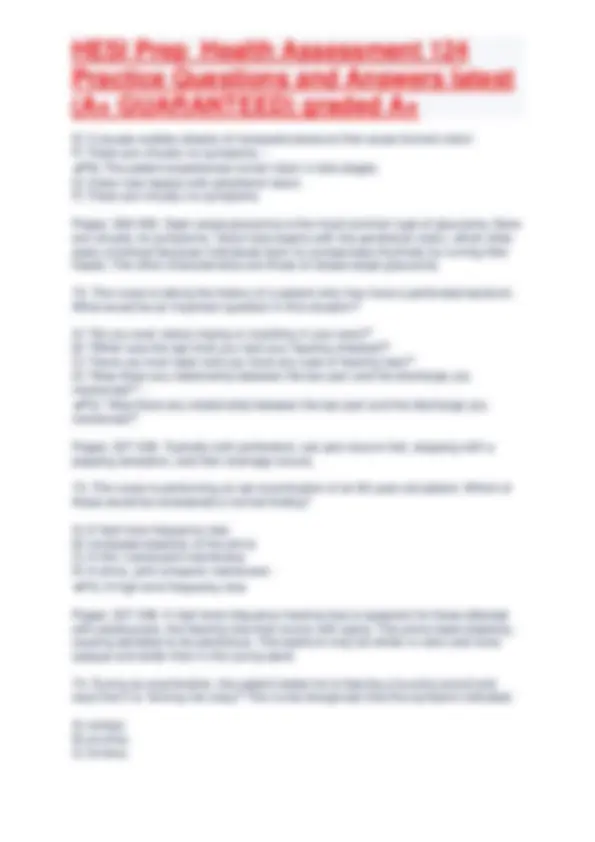

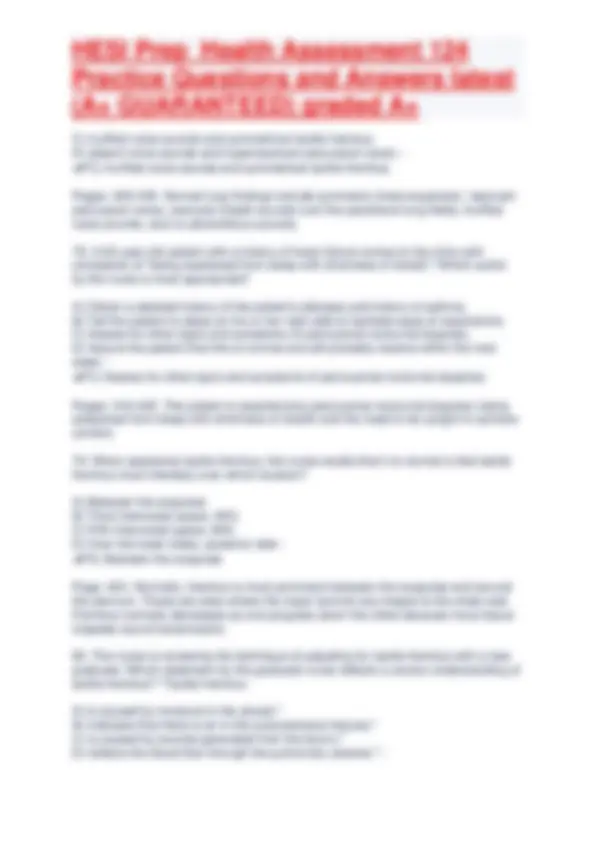
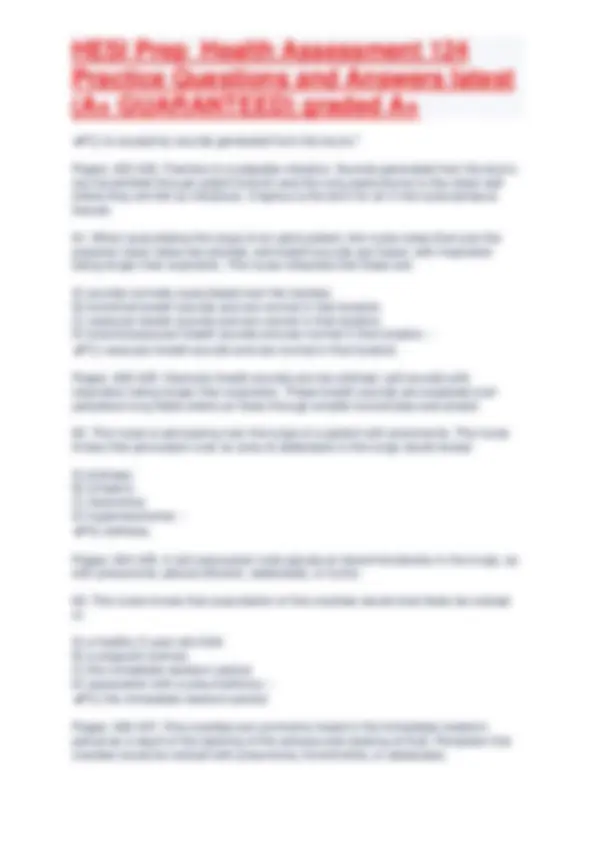
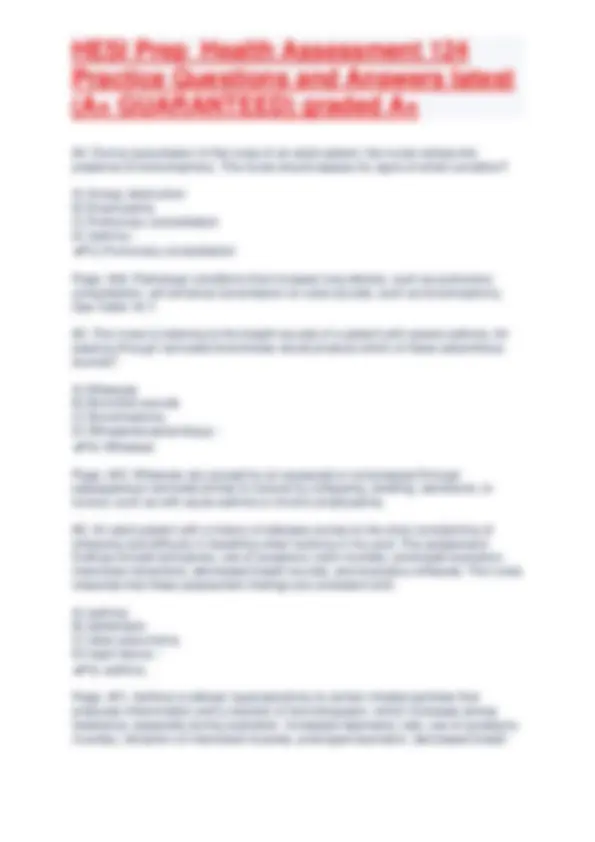
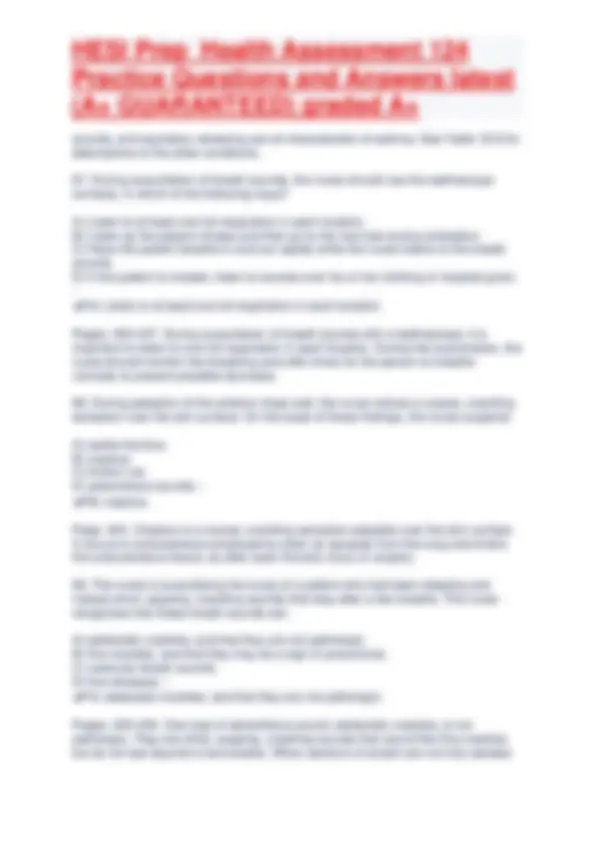
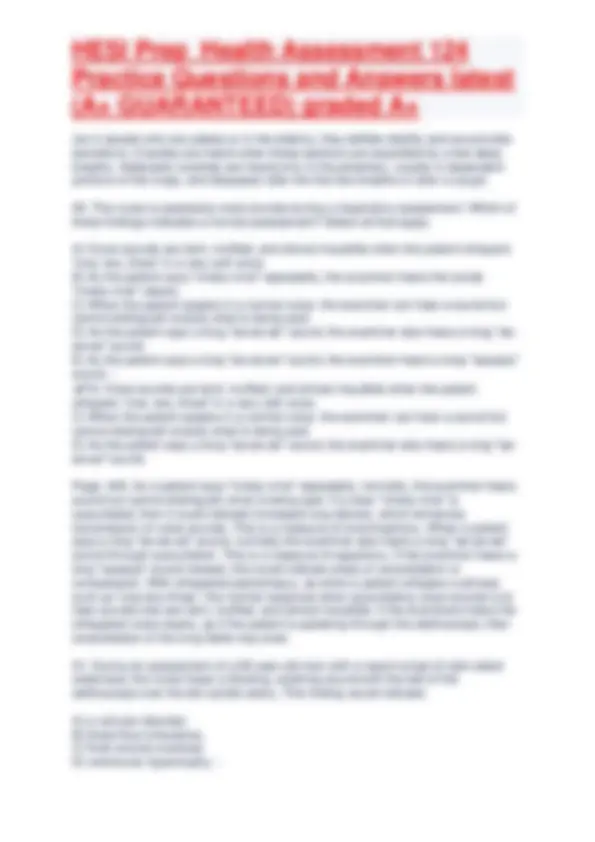
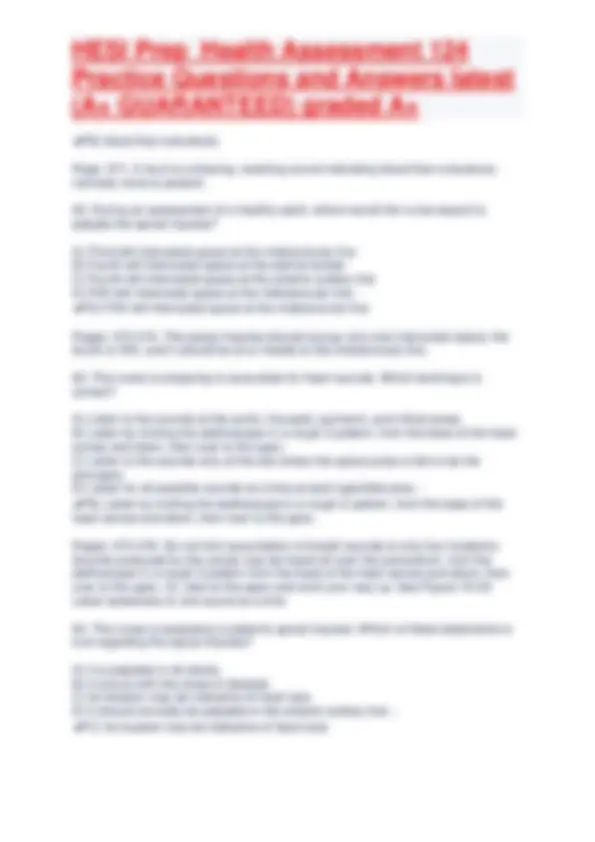
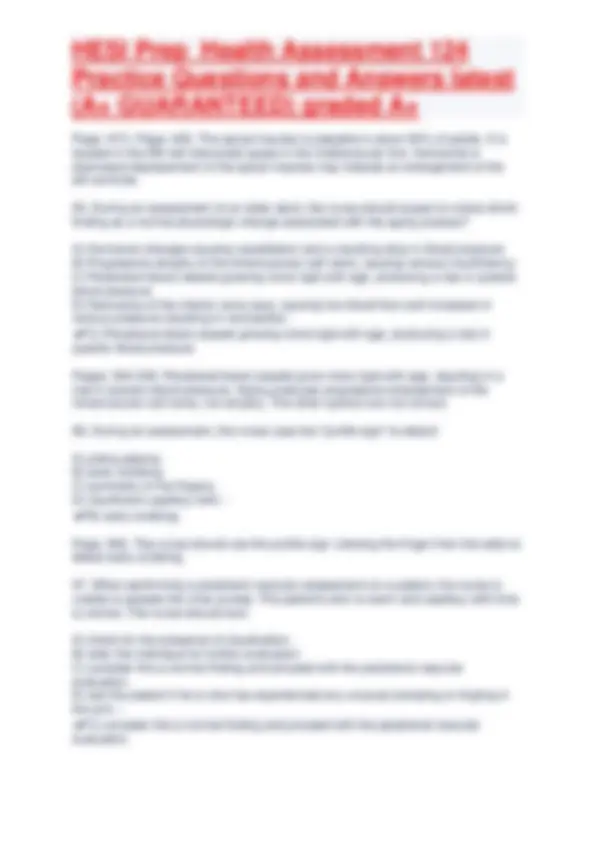
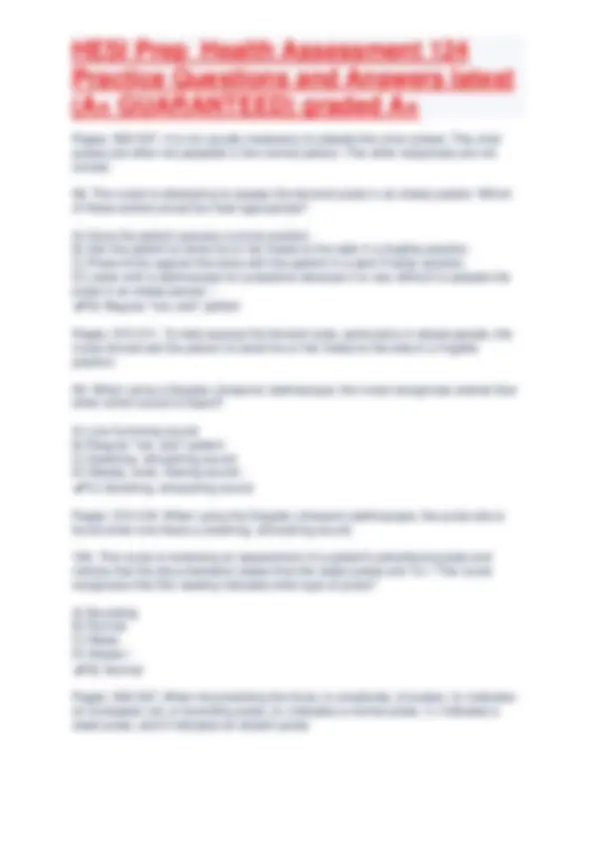
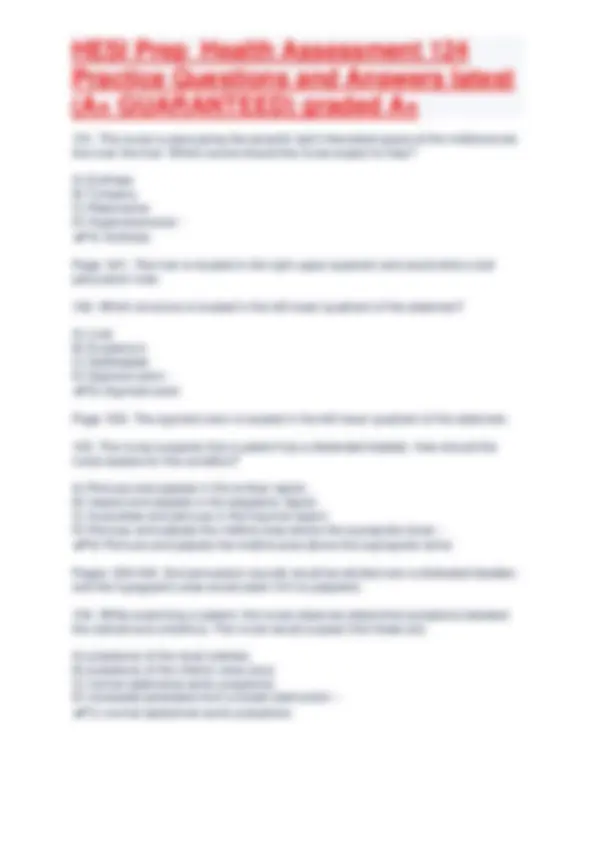
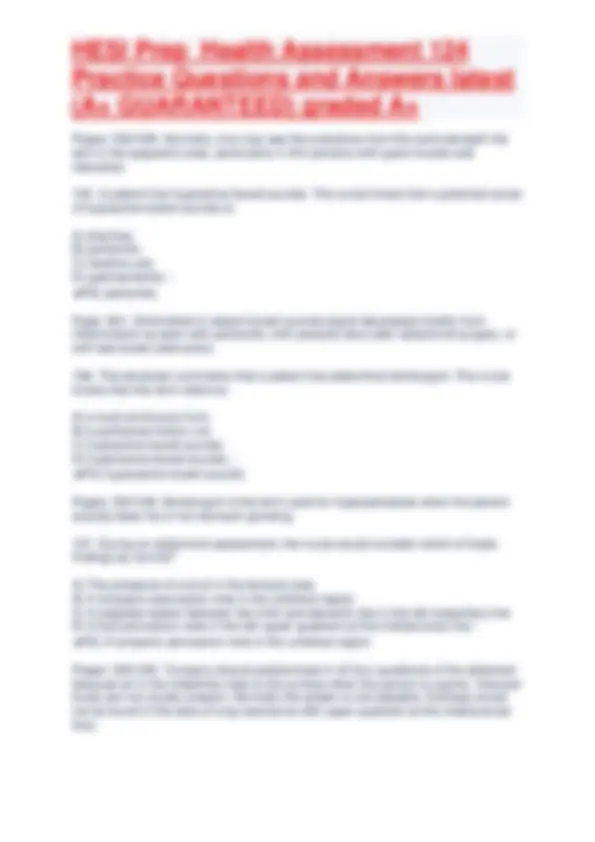
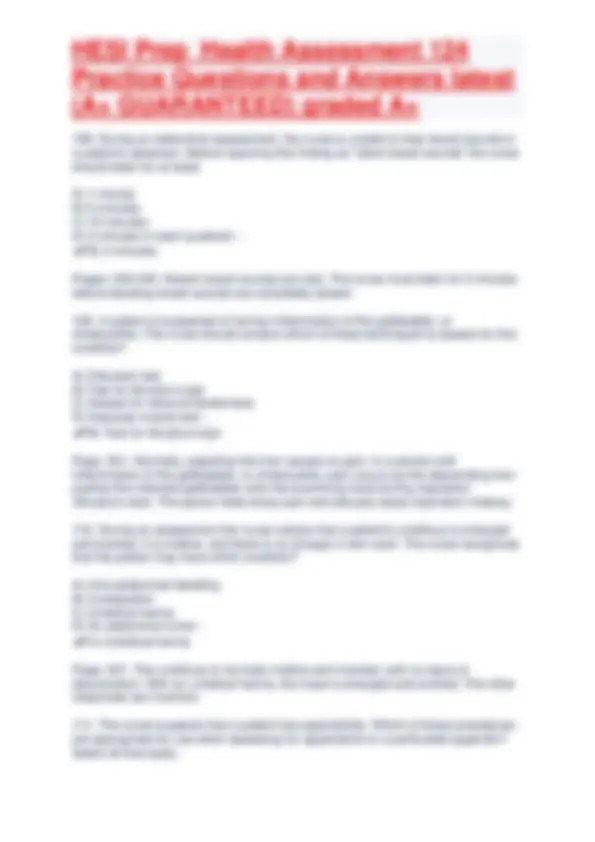
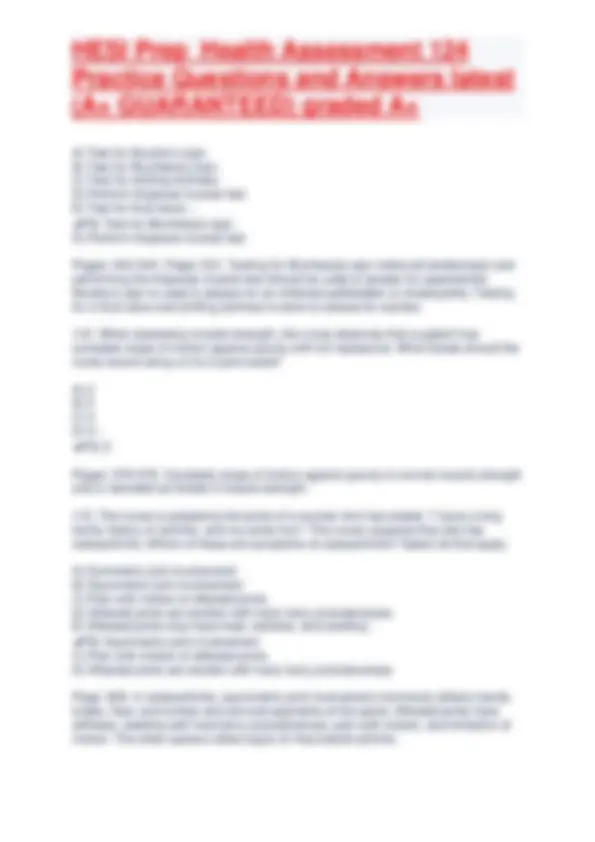
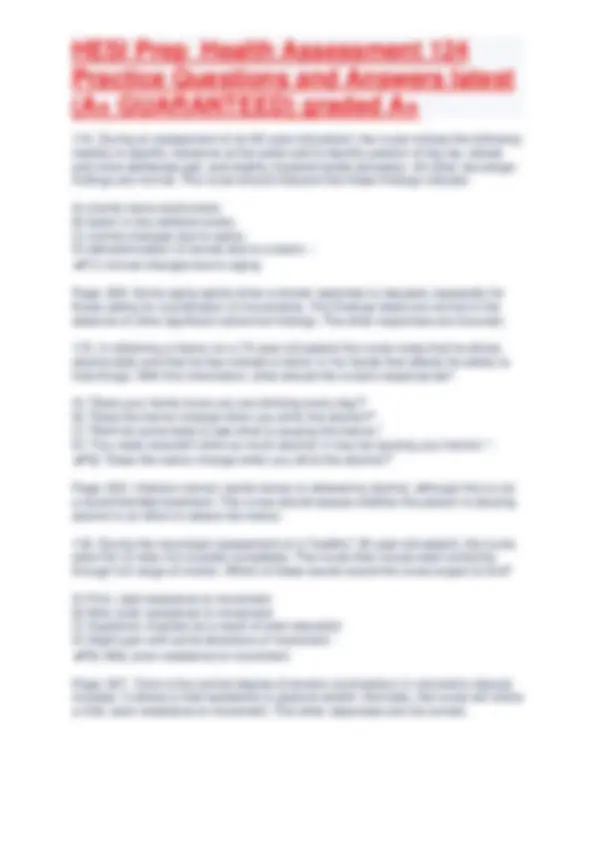
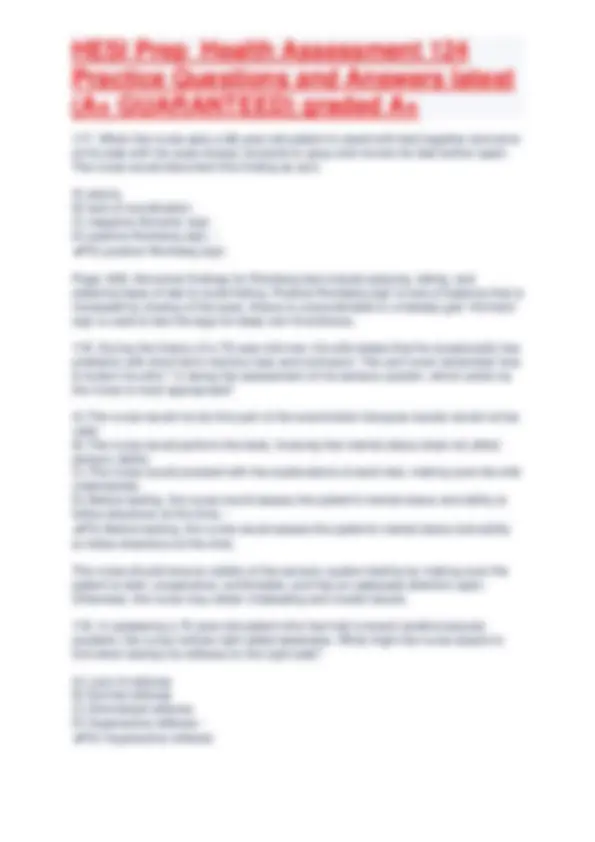
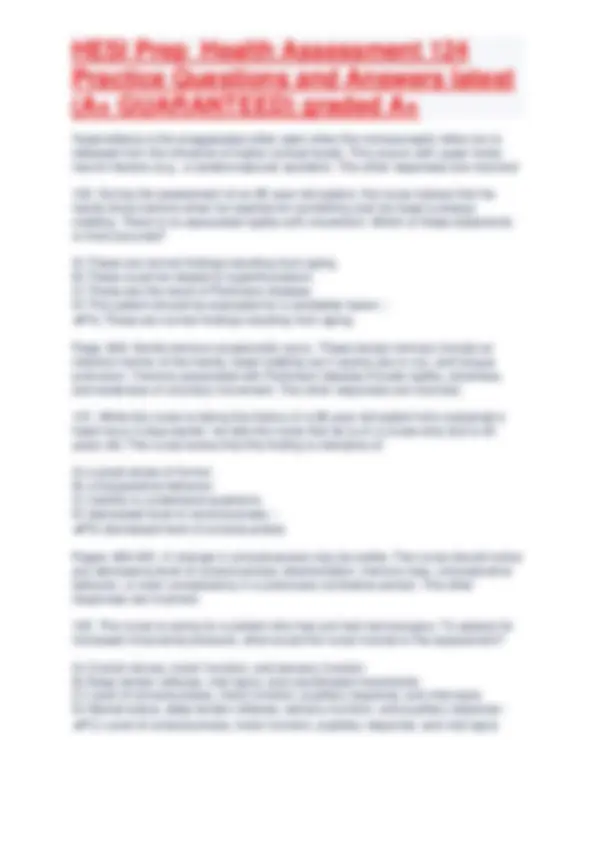
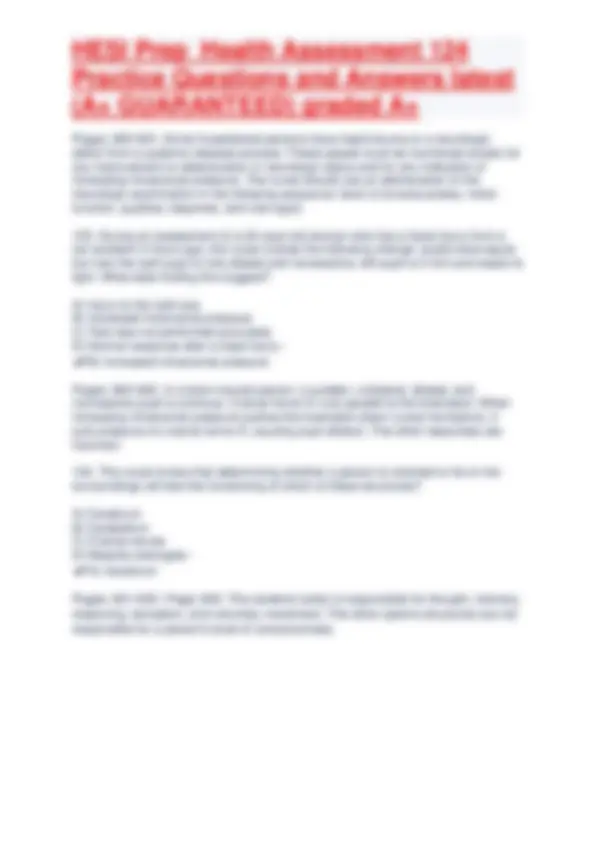


Study with the several resources on Docsity

Earn points by helping other students or get them with a premium plan


Prepare for your exams
Study with the several resources on Docsity

Earn points to download
Earn points by helping other students or get them with a premium plan
Community
Ask the community for help and clear up your study doubts
Discover the best universities in your country according to Docsity users
Free resources
Download our free guides on studying techniques, anxiety management strategies, and thesis advice from Docsity tutors
HESI Prep Health Assessment 124 Practice Questions and Answers latest 2025 (A+ GUARANTEED) graded A+.pdf
Typology: Exams
1 / 42

This page cannot be seen from the preview
Don't miss anything!



































A) Note-taking may impede the nurse's observation of the patient's nonverbal behaviors. B) Note-taking allows the patient to continue at his or her own pace as the nurse records what is said. C) Note-taking allows the nurse to shift attention away from the patient, resulting in an increased comfort level. D) Note-taking allows the nurse to break eye contact with the patient, which may increase his or her level of comfort. - ✔️ A) Note-taking may impede the nurse's observation of the patient's nonverbal behaviors.
Page: 31 Some use of history forms and note-taking may be unavoidable. But be aware that note-taking during the interview has disadvantages. It breaks eye contact too often, and it shifts attention away from the patient, which diminishes his or her sense of importance. It also may interrupt the patient's narrative flow, and it impedes the observation of the patient's nonverbal behavior.
A) Reflection B) Facilitation C) Direct question D) Open-ended question - ✔️ D) Open-ended question
Page: 32 The open-ended question asks for narrative information. It states the topic to be discussed but only in general terms. The nurse should use it to begin the interview, to introduce a new section of questions, and whenever the person introduces a new topic.
A) talking too much. B) using confrontation. C) using biased or leading questions. D) using blunt language to deal with distasteful topics. - ✔️ C) using biased or leading questions.
Page: 36 This is an example of using leading or biased questions. Asking, "You don't smoke, do you?" implies that one answer is "better" than another. If the person wants to please someone, he or she is either forced to answer in a way corresponding to their implied values or is made to feel guilty when admitting the other answer.
A) just changing positions. B) more comfortable in this position. C) tired and needs a break from the interview. D) uncomfortable talking about his son's treatment. - ✔️ D) uncomfortable talking about his son's treatment.
Page: 37 Note the person's position. An open position with the extension of large muscle groups shows relaxation, physical comfort, and a willingness to share information. A closed position with the arms and legs crossed tends to look defensive and anxious. Note any change in posture. If a person in a relaxed position suddenly tenses, it suggests possible discomfort with the new topic.
A) Determine the communication method he prefers. B) Avoid using facial and hand gestures because most hearing-impaired people find this degrading. C) Request a sign language interpreter before meeting with him to help facilitate the communication. D) Speak loudly and with exaggerated facial movement when talking with him because this helps with lip reading. - ✔️ A) Determine the communication method he prefers.
Pages: 40-41 The nurse should ask the deaf person the preferred way to communicate—by signing, lip reading, or writing. If the person prefers lip reading, then the nurse should be sure to face him or her squarely and have good lighting on the nurse's face. The nurse should not exaggerate lip movements because this
Page: 32 Open-ended questions allow for self-expression, build rapport, and obtain narrative information. These features enhance communication during an interview. The other statements are appropriate for closed or direct questions.
A) Collect the patient's data in a direct, face-to-face manner. B) Enter all the data as the patient states it. C) Ask the patient to wait as the nurse enters data. D) Type the data into the computer after the narrative is fully explored. E) Allow the patient to see the monitor during typing. - ✔️ A) Collect the patient's data in a direct, face-to-face manner. D) Type the data into the computer after the narrative is fully explored. E) Allow the patient to see the monitor during typing.
Page: 32 The use of a computer can become a barrier. The nurse should begin the interview as usual by greeting the patient, establishing rapport, and collecting the patient's narrative story in a direct face-to-face manner. Only after the narrative is fully explored should the nurse type data into the computer. When typing, the nurse should position the monitor so that the patient can see it.
A) Ask the patient about the item and its significance. B) Ask the patient to lock the item with other valuables in the hospital's safe. C) Tell the patient that a family member should take valuables home. D) No action is necessary. - ✔️ A) Ask the patient about the item and its significance.
Page: 21 The nurse should inquire about the amulet's meaning. Amulets, such as charms, are often seen as an important means of protection from "evil spirits" by some cultures.
A) have less efficient immune systems and are often ill. B) consider these symptoms a part of normal living, not symptoms of ill health. C) come from Mexico and coughing is normal and healthy there.
D) are usually in a lower socioeconomic group and are more likely to be sick. - ✔️ B) consider these symptoms a part of normal living, not symptoms of ill health.
Page: 27 The nurse needs to identify the meaning of health to the patient, remembering that concepts are derived, in part, from the way in which members of the cultural group define health.
A) A person is able to work and produce. B) A person is happy, stable, and feels good. C) All aspects of the person are in perfect balance. D) A person is able to care for others and function socially. - ✔️ C) All aspects of the person are in perfect balance.
Page: 21 Many Asians believe in the yin/yang theory, in which health is believed to exist when all aspects of the person are in perfect balance. The other statements do not describe this theory.
A) germs and viruses. B) supernatural forces. C) eating imbalanced foods. D) an imbalance within his or her spiritual nature. - ✔️ B) supernatural forces.
Page: 21 The basic premise of the magicoreligious perspective is that the world is seen as an arena in which supernatural forces dominate. The fate of the world and those in it depends on the actions of supernatural forces for good or evil. The other answers do not reflect the magicoreligious perspective.
A) will comply with the treatment prescribed. B) has obviously given up her beliefs in naturalistic causes of disease. C) may also be seeking the assistance of a shaman or medicine man. D) will need extra help in dealing with her illness and may be experiencing a crisis of faith. - ✔️ C) may also be seeking the assistance of a shaman or medicine man.
A) children have spiritual needs that are influenced by their stages of development. B) children have spiritual needs that are direct reflections of what is occurring in their homes. C) religious beliefs rarely affect the parents' perceptions of the illness. D) parents are often the decision makers, and they have no knowledge of their children's spiritual needs. - ✔️ A) children have spiritual needs that are influenced by their stages of development.
Page: 20. Illness during childhood may be an especially difficult clinical situation. Children, as well as adults, have spiritual needs that vary according to the child's developmental level and the religious climate that exists in the family. The other statements are not correct.
A) "Are you of the Christian faith?" B) "Do you want to see a medicine man?" C) "How often do you seek help from medical providers?" D) "What cultural or spiritual beliefs are important to you?" - ✔️ D) "What cultural or spiritual beliefs are important to you?"
Page: 17. The nurse needs to assess the cultural beliefs and practices of the patient. American Indians may seek assistance from a medicine man or shaman, but the nurse should not assume this. An open-ended question regarding cultural and spiritual beliefs is best used initially when performing a cultural assessment.
A) Family history B) Chief complaint C) Medical history D) Health-related beliefs - ✔️ D) Health-related beliefs
Pages: 19-20. Health-related beliefs and practices are one component of a cultural assessment. The other items reflect other aspects of the patient's history.
A. has a history of drug abuse and therefore is not reliable. B. provided consistent information and therefore is reliable. C. smiled throughout interview and therefore is assumed reliable. D. would not answer questions concerning stress and therefore is not reliable. - ✔️ B. provided consistent information and therefore is reliable.
Page: 50. A reliable person always gives the same answers, even when questions are rephrased or are repeated later in the interview. The other statements are not correct.
A. Patient denies usual childhood illnesses. B. Patient states he was a "very healthy" child. C. Patient states sister had measles, but he didn't. D. Patient denies measles, mumps, rubella, chickenpox, pertussis, and strep throat. - ✔️ D. Patient denies measles, mumps, rubella, chickenpox, pertussis, and strep throat.
Page: 51. Childhood illnesses include measles, mumps, rubella, chickenpox, pertussis, and strep throat. Avoid recording "usual childhood illnesses" because an illness common in the person's childhood may be unusual today (e.g., measles).
A. "Maybe she is just teething." B. "I will check her ear for an ear infection." C. "Are you sure she is really having pain?" D. "Please describe what she is doing to indicate she is having pain." - ✔️ D. "Please describe what she is doing to indicate she is having pain."
Page: 60. With a very young child, ask the parent, "How do you know the child is in pain?" Pulling at ears alerts parent to ear pain. The statements about teething and questioning whether the child is really having pain do not explore the symptoms, which should be done before a physical examination.
A. The child's birth weight B. The age at which he crawled C. Whether he has had the measles D. Reactions to previous hospitalizations -
Page: 61. Questions about tooth loss, ability to tell time, and ability to tie shoelaces are appropriate questions for a developmental assessment. Questions about junk food intake and vitamins are part of a nutritional history. Questions about food allergies are not part of a developmental history.
A) Examining the patient's electroencephalogram B) Observing the patient as he or she performs an IQ test C) Observing the patient and inferring health or dysfunction D) Examining the patient's response to a specific set of questions - ✔️ C) Observing the patient and inferring health or dysfunction
Page: 71. Mental status cannot be scrutinized directly like the characteristics of skin or heart sounds. Its functioning is inferred through assessment of an individual's behaviors, such as consciousness, language, mood and affect, and other aspects.
A) will have no decrease in any of his abilities, including response time. B) will have difficulty on tests of remote memory because this typically decreases with age. C) may take a little longer to respond, but his general knowledge and abilities should not have declined. D) will have had a decrease in his response time because of language loss and a decrease in general knowledge. - ✔️ C) may take a little longer to respond, but his general knowledge and abilities should not have declined.
Page: 72. The aging process leaves the parameters of mental status mostly intact. There is no decrease in general knowledge and little or no loss in vocabulary. Response time is slower than in youth. It takes a bit longer for the brain to process information and to react to it. Recent memory, which requires some processing is somewhat decreased with aging, but remote memory is not affected.
A) A patient's family is the best resource for information about the patient's coping skills. B) It is usually sufficient to gather mental status information during the health history interview. C) It takes an enormous amount of extra time to integrate the mental status examination into the health history interview.
D) It is usually necessary to perform a complete mental status examination to get a good idea of the patient's level of functioning. - ✔️ B) It is usually sufficient to gather mental status information during the health history interview.
Page: 73. The full mental status examination is a systematic check of emotional and cognitive functioning. The steps described here, though, rarely need to be taken in their entirety. Usually, one can assess mental status through the context of the health history interview.
A) "How do you feel today?" B) "Would you please repeat the following words?" C) "Have these medications had any effect on your pain?" D) "Has this pain affected your ability to get dressed by yourself?" - ✔️ A) "How do you feel today?"
Page: 74. Judge mood and affect by body language and facial expression and by asking directly, "How do you feel today?" or "How do you usually feel?" The mood should be appropriate to the person's place and condition and should change appropriately with topics.
A) "Do you feel that you are being watched, followed, or controlled?" B) "Tell me about what you plan to do once you are discharged from the hospital." C) "What does the statement, 'People in glass houses shouldn't throw stones,' mean to you?" D) "What would you do if you found a stamped, addressed envelope lying on the sidewalk?" - ✔️ B) "Tell me about what you plan to do once you are discharged from the hospital."
Pages: 76-77. A person exercises judgment when he or she can compare and evaluate the alternatives in a situation and reach an appropriate course of action. Rather than testing the person's response to a hypothetical situation (as illustrated in the option with the envelope), the nurse should be more interested in the person's judgment about daily or long-term goals, the likelihood of acting in response to delusions or hallucinations and the capacity for violent or suicidal behavior.
A) Avoid palpation of reported "tender" areas because this may cause the patient pain. B) Quickly palpate a tender area to avoid any discomfort that the patient may experience. C) Begin the assessment with deep palpation, encouraging the patient to relax and take deep breaths. D) Start with light palpation to detect surface characteristics and to accustom the patient to being touched. - ✔️ D) Start with light palpation to detect surface characteristics and to accustom the patient to being touched.
Pages: 115-116. Light palpation is performed initially to detect any surface characteristics and to accustom the person to being touched. Tender areas should be palpated last, not first.
A) Palpating the thorax of an infant B) Palpating the kidneys and uterus C) Assessing pulsations and vibrations D) Assessing the presence of tenderness and pain - ✔️ B) Palpating the kidneys and uterus
Pages: 115-116. Bimanual palpation requires the use of both hands to envelop or capture certain body parts or organs such as the kidneys, uterus, or adnexa. The other situations are not appropriate for bimanual palpation.
A) consider this a normal finding. B) palpate this area for an underlying mass. C) reposition the hands and attempt to percuss in this area again. D) consider this an abnormal finding and refer the patient for additional treatment. - ✔️ A) consider this a normal finding.
Pages: 116-117. Percussion over relatively dense organs, such as the liver or spleen, will produce a dull sound. The other responses are not correct.
A) auscultate over the area with a fetoscope. B) use a goniometer to measure the pulsations. C) use a Doppler device to check for pulsations over the area. D) check for the presence of pulsations with a stethoscope. - ✔️ C) use a Doppler device to check for pulsations over the area.
Page: 120. Doppler devices are used to augment pulse or blood pressure measurements. Goniometers measure joint range of motion. A fetoscope is used to auscultate fetal heart tones. Stethoscopes are used to auscultate breath, bowel, and heart sounds.
A) There is no need to wash one's hands after removing gloves, as long as the gloves are still intact. B) Wash hands before and after every physical patient encounter. C) Wash hands between the examination of each body system to prevent the spread of bacteria from one part of the body to another. D) Wear gloves throughout the entire examination to demonstrate to the patient concern regarding the spread of infectious diseases. - ✔️ B) Wash hands before and after every physical patient encounter.
Page: 120. The nurse should wash his or her hands before and after every physical patient encounter; after contact with blood, body fluids, secretions, and excretions; after contact with any equipment contaminated with body fluids; and after removing gloves. Hands should be washed after gloves have been removed, even if the gloves appear to be intact. Gloves should be worn when there is potential contact with any body fluids.
A) When the infant is sleeping B) At the end of the examination C) Before auscultation of the thorax D) Halfway through the examination - ✔️ B) At the end of the examination
Page: 123. Elicit the Moro or "startle" reflex at the end of the examination because it may cause the infant to cry.
A) "When did the pain start?" B) "Is the pain a stabbing pain?" C) "Is it a sharp pain or dull pain?" D) "What does your pain feel like?" - ✔️ D) "What does your pain feel like?"
Page: 164. To assess the quality of a person's pain, have the patient describe the pain in his or her own words.
A) The absorption of nutrients may be impaired. B) The constipation may represent a food allergy. C) She may need emergency surgery for the problem. D) The gastrointestinal problem will increase her caloric demand. - ✔️ A) The absorption of nutrients may be impaired.
Page: 182. Gastrointestinal symptoms such as vomiting, diarrhea, or constipation may interfere with nutrient intake or absorption. The other responses are not correct.
A) Certain drugs can affect the metabolism of nutrients. B) The nurse needs to assess the patient for allergic reactions. C) Medications need to be documented on the record for the physician's review. D) Medications can affect one's memory and ability to identify food eaten in the last 24 hours. - ✔️ A) Certain drugs can affect the metabolism of nutrients.
Page: 183 Analgesics, antacids, anticonvulsants, antibiotics, diuretics, laxatives, antineoplastic drugs, steroids, and oral contraceptives are drugs that can interact with nutrients, impairing their digestion, absorption, metabolism, or use. The other responses are not correct.
A) Increase in taste and smell
B) Living alone on a fixed income C) Change in cardiovascular status D) Increase in gastrointestinal motility and absorption - ✔️ B) Living alone on a fixed income
Page: 176. Socioeconomic conditions frequently affect the nutritional status of the aging adult; these factors should be closely evaluated. Physical limitations, income, and social isolation are frequent problems that interfere with the acquisition of a balanced diet. A decrease in taste and smell and decreased gastrointestinal motility and absorption occur with aging. Cardiovascular status is not a factor that affects an elderly person's nutritional status.
A) These measurements are no longer necessary for the elderly. B) Derived weight measures may be difficult to interpret because of wide ranges of normal. C) These measurements may not be accurate because of changes in skin and fat distribution. D) Measurements may be difficult to obtain if the patient is unable to flex his elbow to at least 90 degrees. - ✔️ C) These measurements may not be accurate because of changes in skin and fat distribution.
Page: 191 Accurate mid-upper arm circumference and triceps skinfold measurements are difficult to obtain and interpret in older adults because of sagging skin, changes in fat distribution, and declining muscle mass. Body mass index and waist-to-hip ratio are better indicators of obesity in the elderly.
A) Changes in fat distribution will affect the waist-to-hip ratio. B) Height measurements may not be accurate because of changes in bone. C) Declining muscle mass will affect the triceps skinfold measure. D) Mid-arm circumference is difficult to obtain because of loss of skin elasticity. - ✔️ B) Height measurements may not be accurate because of changes in bone.
Page: 191. Height measures may not be accurate in individuals confined to a bed or wheelchair or those over 60 years of age because of osteoporotic changes.
A) Smooth mucous membranes and lips B) Dry mucous membranes and cracked lips C) Pale mucous membranes D) White patches on the mucous membranes - ✔️ B) Dry mucous membranes and cracked lips
Page: 215. With dehydration, mucous membranes look dry and lips look parched and cracked. The other responses are not found in dehydration.
A) Anasarca B) Scleroderma C) Pedal erythema D) Clubbing of the nails - ✔️ D) Clubbing of the nails
Pages: 217-218. Clubbing of the nails occurs with congenital cyanotic heart disease, neoplastic, and pulmonary diseases. The other responses are assessment findings not associated with pulmonary diseases.
A) Severe obesity B) Childhood growth spurts C) Severe dehydration D) Connective tissue disorders such as scleroderma - ✔️ C) Severe dehydration
Page: 215. Decreased skin turgor is associated with severe dehydration or extreme weight loss.
A) tell the patient to watch the lesion and report back in 2 months. B) refer the patient because of the suspicion of melanoma on the basis of her symptoms.
C) ask additional questions regarding environmental irritants that may have caused this condition. D) suspect that this is a compound nevus, which is very common in young to middle- aged adults. - ✔️ B) refer the patient because of the suspicion of melanoma on the basis of her symptoms.
The ABCD danger signs of melanoma are asymmetry, border irregularity, color variation, and diameter. In addition, individuals may report a change in size, development of itching, burning, bleeding, or a new-pigmented lesion. Any of these signs raise suspicion of malignant melanoma and warrant immediate referral.
A) a nail base that is firm and slightly tender. B) curved nails with a convex profile and ridges across the nail. C) a nail base that feels spongy with an angle of the nail base of 150 degrees. D) an angle of the nail base of 180 degrees or greater with a nail base that feels spongy. - ✔️ D) an angle of the nail base of 180 degrees or greater with a nail base that feels spongy.
Pages: 217-218. The normal nail is firm at its base and has an angle of 160 degrees. In clubbing, the angle straightens to 180 degrees or greater and the nail base feels spongy.
A) Splinter hemorrhages B) Paronychia C) Pitting D) Beau lines - ✔️ C) Pitting
Pages: 248-250. Pitting nails are characterized by sharply defined pitting and crumbling of the nails with distal detachment, and they are associated with psoriasis. See Table 12- 1 3 for descriptions of the other terms.
A) Tachycardia B) Constipation